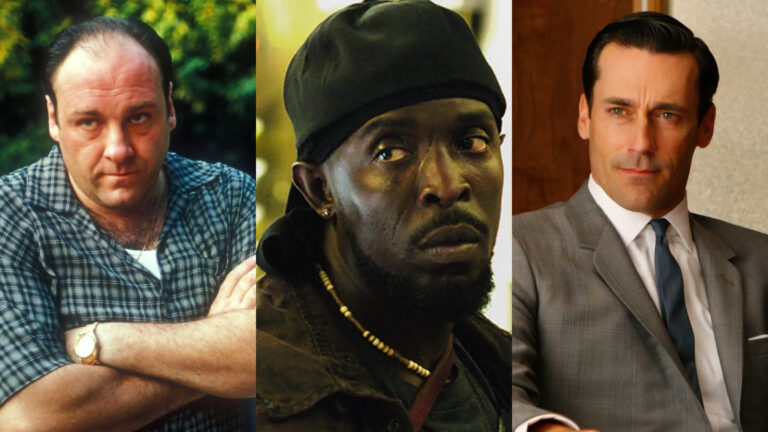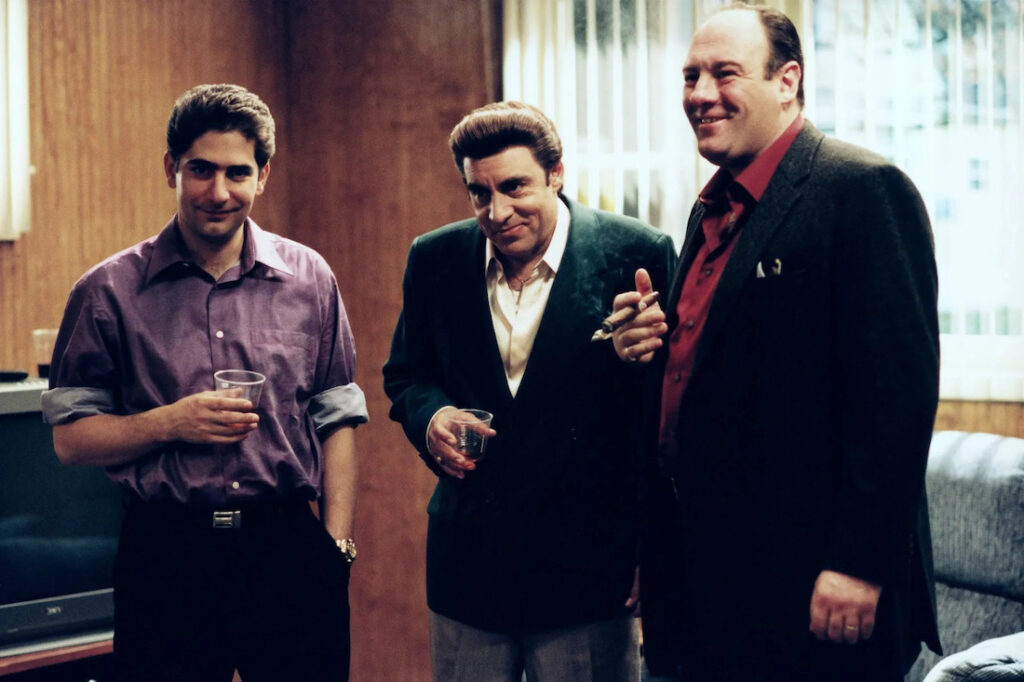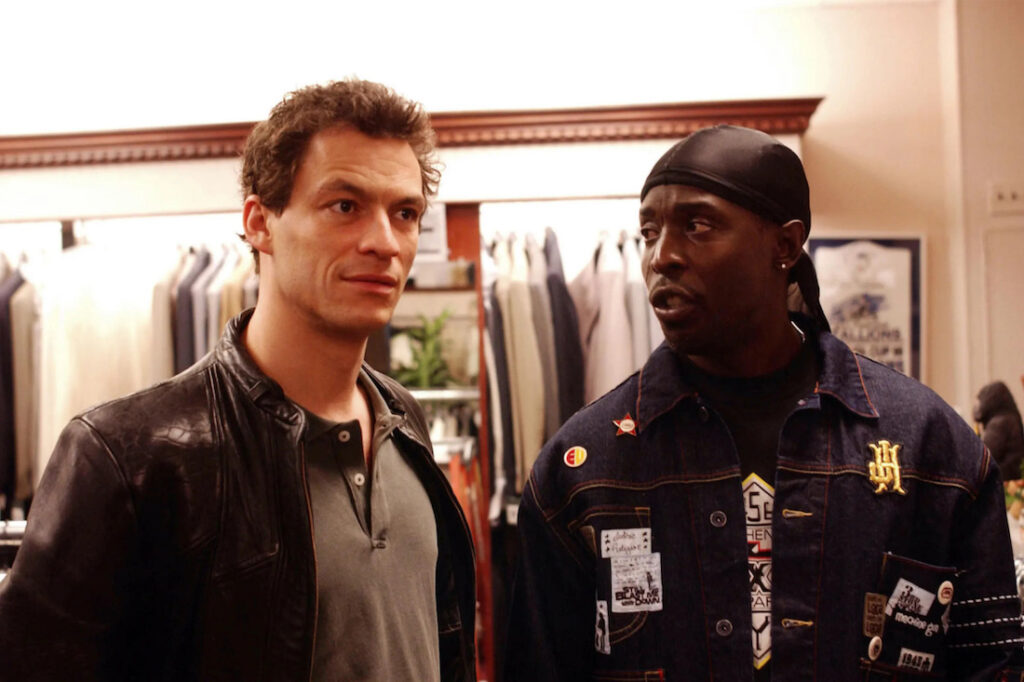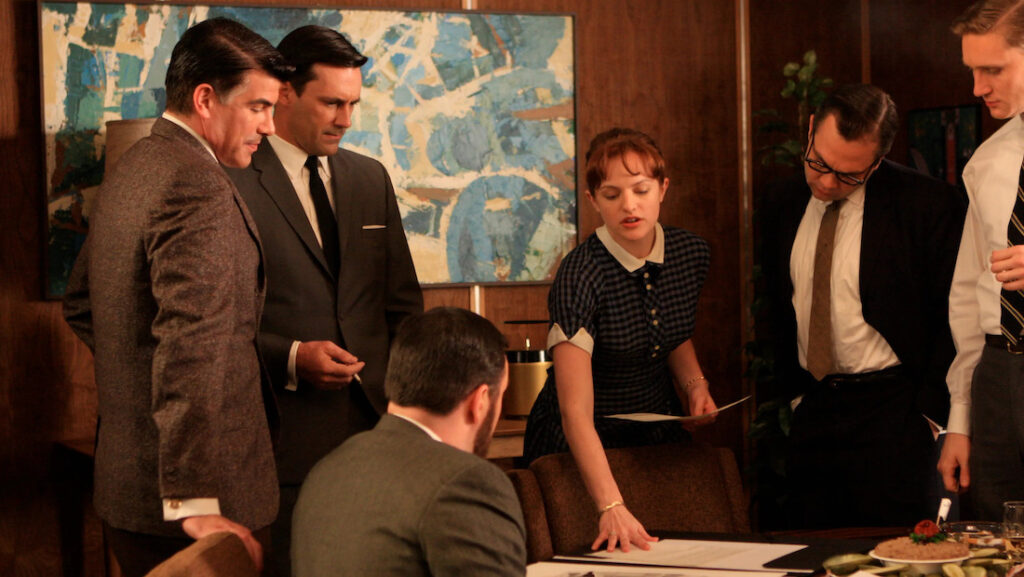By Martin Keady · December 8, 2023

Perhaps it is the publication of Peter Biskind’s new book, Pandora’s Box: The Greed, Lust, and Lies That Broke Television, that definitively marks the end of the first (and possibly last) golden age of television. If he is right and late 20th-century/early 21st-century television is following 70s cinema as another lost golden age of screen storytelling, then its totemic works – its equivalent of The Godfather and Chinatown as the greatest works of a great era – are surely The Sopranos, The Wire, and Mad Men. They are TV’s Holy Trinity.
These three series combine the singular vision of their creators – David Chase, David Simon, and Matthew Wiener, respectively – with what might be called a structuralist, even societalist, approach to storytelling. They each looked not just at individuals or small groups but at large sub-sections of US society. Indeed, The Wire examined a whole city and by extension the nature of Western civilization.
In The Sopranos, the sub-section of society that is examined is organized crime; in Mad Men, it is the US advertising industry of the 1960s; and in The Wire, it is not just one part of society that is examined but the whole of society, from politicians to junkies, via the drug dealers, corrupt lawyers and everyone else who make the drug trade possible. The title of The Wire explicitly refers to the wire-taps used by the police to surveil drug dealers, but implicitly it refers to the wire or thread that somehow connects even the most apparently disconnected parts of a society – a wire or thread that is now seriously frayed and perhaps even broken.
It is this epic scope – taking in a whole Mafia mob or family, a whole industry, and ultimately a whole city or civilization (the original meaning of civilization, from the Latin word for ‘civis’, being ‘city-dweller’) – that unites The Sopranos, Mad Men and The Wire. For all the merits of the other great TV series of the last quarter-century, notably Breaking Bad and Succession, no other show comes close to matching the truly panoramic view of TV’s Holy Trinity.
Although The Sopranos, The Wire, and Mad Men were made separately, they dovetailed beautifully, with one succeeding the other over a period of 16 years. Thus, it is possible to consider them chronologically and thereby identify their defining traits.

‘The Sopranos’
In the first episode of The Sopranos, Tony Soprano lamented to his psychiatrist: “Lately I’m getting the feeling that I came in at the end. The best is over.” Although he cannot say so to his shrink, he is referring to “the end” of the Mafia’s domination of American crime, which had lasted since prohibition effectively created American organized crime in the first place.
The irony is, of course, that The Sopranos itself was getting in at the beginning of the golden age of television. It was the first truly great TV show, whose narrative complexity, extraordinary production values, and sheer artistry allowed television, which had generally been looked down upon since it had first emerged in the post-war period, to match those qualities in film and literature. Tony himself may have felt that he was the last of the old guard of Italian-American heads of crime families, but The Sopranos itself was in the vanguard of new and truly great television.
The Sopranos used the episodic nature of TV, which is more comparable to the effect of reading a novel over time than the effect of seeing a film (however long it is) in one sitting, to convey the slow but profound deterioration of Italian-American criminal overlordship, in the face of multiple threats from newer immigrants to the US, ranging from Eastern Europeans to Islamicists. And in doing so, it also showed the slow but profound deterioration of so many other aspects of American life.
Because it was the first truly great TV show, just as Citizen Kane (1941) was the first truly great American film or at least sound film, The Sopranos almost literally fizzed (and sometimes exploded) with the same sense of invention, the “anything-goes” possibility that is arguably the defining quality of any genuinely innovative work in any art-form.
That was evident in stand-alone episodes, notably Pine Barrens (Season Three, Episode 11), which is often cited as The Sopranos’ equivalent of The Soup Nazi episode of Seinfeld, namely the one episode that somehow summed up the whole series.
But it was also evident in entire seasons or stretches of seasons. The “Tony In A Coma” sequence that opened Season Six (after Tony had been shot by his Uncle “Junior”) is sometimes seen as the moment The Sopranos “jumped the shark” or lost its way. However, even if that was partly true, it ultimately gave way to the sublime ending of the whole series, in which Tony tried to reimagine his life (doing everything from taking peyote to preparing for a mob war with a New York family) and The Sopranos’ greatest sub-plot of all, in which Vito, one of Tony’s lieutenants, is outed as gay and has to flee for his life to a small town upstate.
Just like Citizen Kane in film and to some extent The Great Gatsby in literature, The Sopranos was the original great work in its medium – a TV show that could stand comparison with any other work in any other art form, especially any other storytelling art-form – and it will always retain that title.

‘The Wire’
However, for all its greatness, The Sopranos might ultimately come to be regarded as the John the Baptist to The Wire’s Christ, because The Wire’s creator, David Simon, built upon it spectacularly. Rather than focusing on a single individual (such as a Tony Soprano) or even a single crime family (all of the Sopranos), Simon somehow focused on an entire city – his hometown of Baltimore – and showed how every part of it, from the dockyard to the schoolyard, was complicit in the drug trade that threatened to destroy it.
The different seasons of The Sopranos showed different stages in the evolution of Tony Soprano and his family. By contrast, the different seasons of The Wire showed different parts of a city and how they contributed, consciously or otherwise, to the drug trade tearing it apart.
Season One was relatively conventional, at least in comparison with the following seasons, in that it was a crime drama, or “cops and robbers” (or, more accurately, “cops and dealers”) show. However, the genius of David Simon was to show both sides of that equation – the cops and the criminals – and the similarities between them.
Both sides have oppressive leaders (Bill Rawls for the cops and Avon Barksdale for the dealers) and put-upon subordinates (such as Jimmy McNulty for the cops and poor, tragic Wallace for the dealers), and all the “bureaucracy”, or attempts at bureaucracy, between them. And brilliantly, that first season even took in the side-hustlers – those who were neither cops nor dealers – notably Omar Little, the openly gay, concealed shotgun-carrying robber of drug dealers, who Stephen King famously called the greatest fictional criminal since Robin Hood.
That was all in the first season of The Wire, but what followed is perhaps more comparable to the evolution in the music of a great band – indeed, the greatest band, The Beatles – than it is to other narrative works. After the brilliant debut of Season One (the show’s Rubber Soul), there was the even better follow-up of Season Two (the show’s Revolver), in which Frank Sobotka, the struggling leader of Baltimore’s dockers, became arguably the greatest American tragic hero since Willy Loman over half a century earlier.
Then came season three, in which a police chief tries to defeat the drug trade by effectively legalizing it, at least in one part of the city, which was so genuinely psychedelic that it bears comparison with The Beatles’ psychedelic masterpiece, Sergeant Pepper. Season four, looking at how young children were initiated into the drug trade, was effectively the “back-to-basics” masterpiece that The Beatles’ White Album was. And season five, the finale, somehow wrapped up the simultaneously sprawling and supremely focused story of The Wire as beautifully as Abbey Road did for The Beatles.
The Wire is comparable to the great albums of The Beatles because it is comparable to all great art. Indeed, it is the fifth and final part of the great Western storytelling tradition, which began with Homer’s epic poems and continued with the plays of Shakespeare, the novels of Dickens, and the operas of Wagner. The Wire isn’t just the greatest television show ever but the greatest work of screen storytelling ever.

‘Mad Men’
The outlier in TV’s Holy Trinity is Mad Men, which was first aired (in 2007) after The Sopranos had ended and The Wire was approaching its final season. And the reason it is an outlier among these three great shows is that it is not a crime drama, like The Sopranos, or even a police procedural series, like The Wire. Instead, it is a workplace drama, just one set in probably the most glamorous, even mythical, workplace there ever was.
Mad Men is a double pun on the Madison Avenue advertising men who did so much to create American and indeed Western consumerism. Encompassing the entire 1960s, Mad Men showed how a workplace, albeit a truly new kind of workplace such as the US advertising industry of that fabled decade, could be every bit as dramatic, if not more so, as the crime wars of the late 20th and early 21st centuries.
Raymond Chandler, the great originator of American crime fiction, famously wrote: “When stumped, have a man come through a door with a gun”. Guns are inherently dramatic and there are certainly plenty of them in both The Sopranos and The Wire. By contrast, there is an almost complete lack of guns in Mad Men, with the only two significant exceptions coming during a street robbery and an accidental shooting during a hunting trip.
That testifies to the dramatic increase in gun ownership and use in America during the late 20th century, but it also adheres to the central idea of Mad Men, which is that the most dramatic part of our lives is often our working life. Mad Men showed how the everyday stuff of office life – workplace romances, the competition to scale the career ladder, et al – could be just as dramatic as having a man enter with a gun, and all the more so when that working life is taking place during the unforgettable decade that was the 1960s.
In so many ways, from the Cold War to the Battle of the Sexes, the 1960s was the decade that made the end of the 20th century, and the titular Ad/Mad Men did so much to make that decade. They did so through their creative genius, as evidenced in the real-life ad campaigns that the series used, which achieved the same extraordinary verisimilitude that The Wire and The Sopranos achieved with their use of real locations in New Jersey and Baltimore. However, they also did so through their duplicity, because the ad men often lied in those campaigns, just as they often lied in their private lives.
In some ways, Mad Men is the third of TV’s Holy Trinity; it came last of the three and was not so obviously, even flashily dramatic as The Sopranos and The Wire. Yet its achievement was arguably even greater than that of its two predecessors because it showed how office arguments over the hiring of female copywriters or the installation of computers could be just as dramatic, if not more dramatic, as the gun battles that punctuate both The Sopranos and The Wire.
If Peter Biskind is right and the great golden age of television has already ended, for reasons including the transition from broadcasting to “narrowcasting” that is the hallmark of so much streaming, then these three series are its lasting monuments. And as such, they are required viewing for any self-respecting screenwriter in 2023. Just as it is better to read all of Shakespeare than it is to read the work of every other dramatist but Shakespeare, it is better to watch, and learn from, these three truly titanic TV series than it is to watch every other series but them.